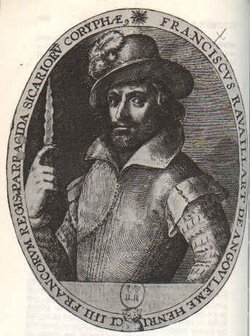|
|
François Ravaillac (1578 – May 27, 1610) was the killer of Henry IV of France.
He was born at Touvre, near Angoulême. He was of undistinguished origins and began life as a servant, but later became a school teacher.
Highly religious, he sought admission to the Feuillants order, but after a short probation he was dismissed as he was prey to visions. An application for admission to the Society of Jesus was unsuccessful in 1606.
In 1609 he had a vision telling him to convince Henry to convert the Huguenots. Unable to meet with the king he interpreted the king's decision to invade the Netherlands as the start of a war against the Pope. Determined to stop the king he decided to kill him. He carried out the act on May 14, 1610, stabbing the king to death on the Rue de la Ferronnerie in Paris (now south of the Forum des Halles). He was immediately seized and taken to the Hôtel de Retz, to avoid a mob lynching, before being transferred to the Conciergerie.
In the course of his trial he was frequently put to the torture, but denied that he had been prompted by any one or had any accomplices. On May 27 he was taken to the Place de Grève and there was tortured before being dispatched by being pulled apart by four horses. Alistair Horne describes his torture: "Before being drawn and quartered, . . . he was scalded with burning sulphur, molten lead and boiling oil and resin, his flesh then being torn by pincers." His parents were forced into exile and the rest of his family was ordered to never use the name Ravaillac.
See also
- Robert-François Damiens, another regicide; description of the regicides' method of execution

